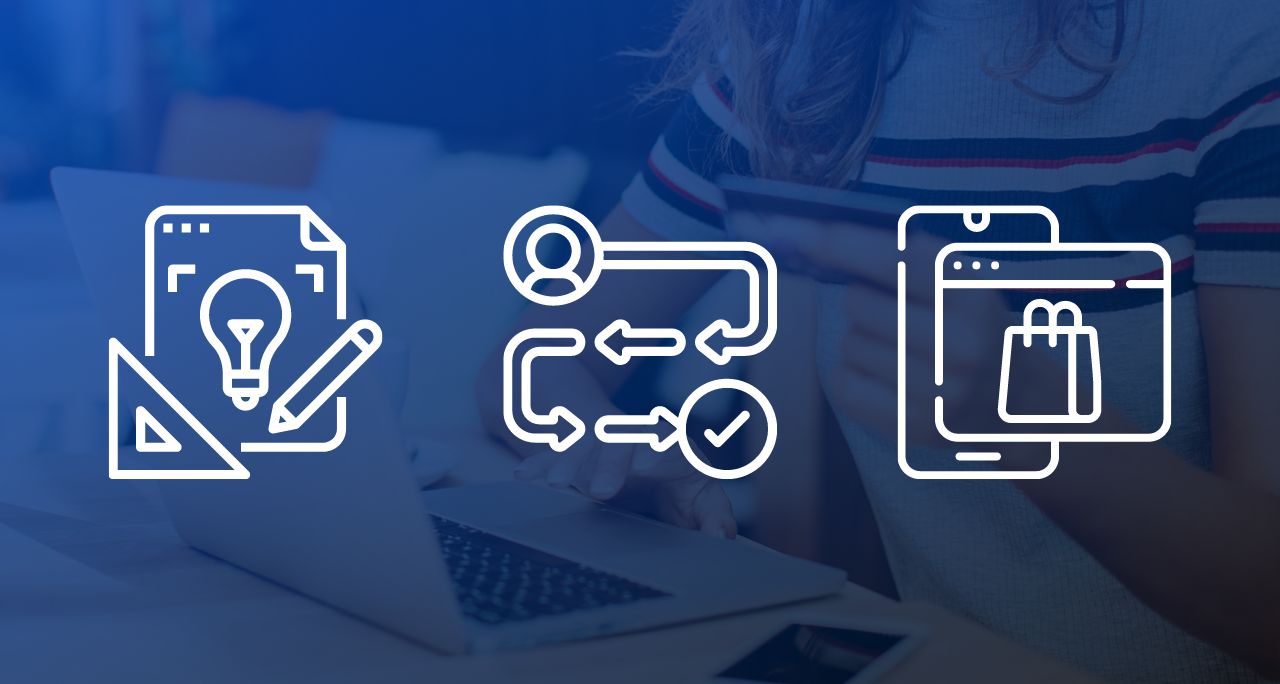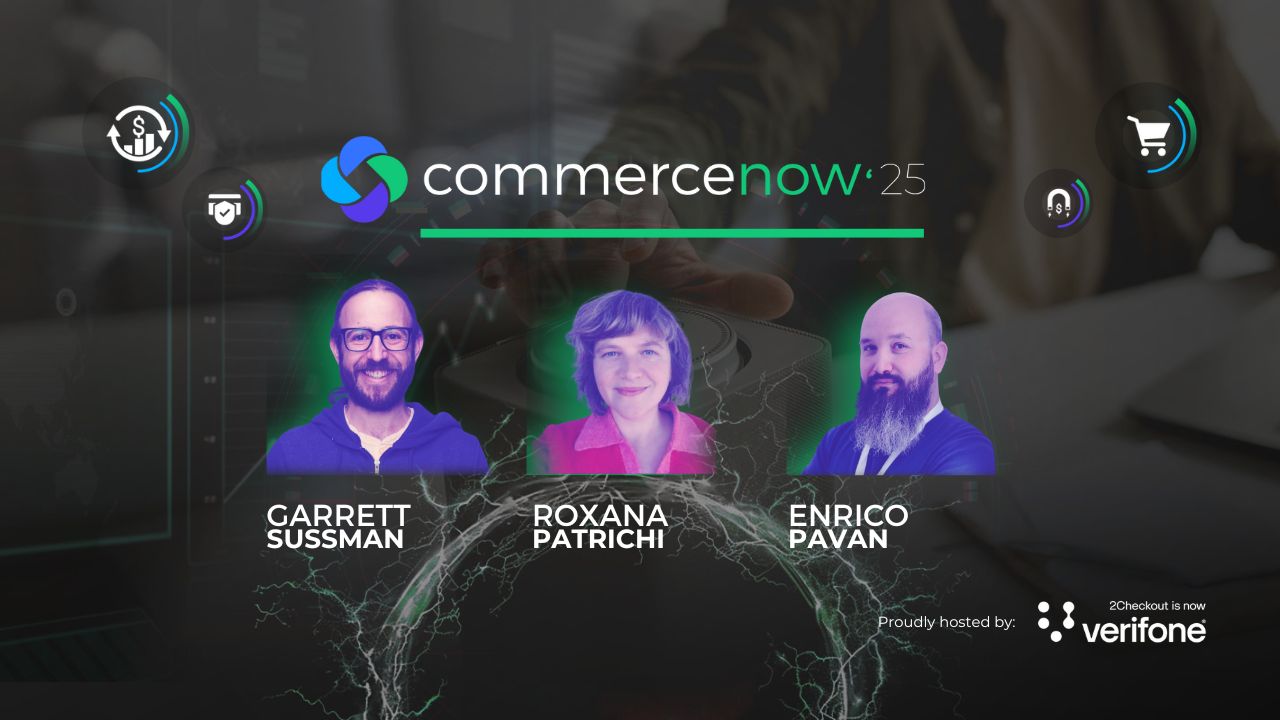How would you describe your customer journey map? If you don’t already have one, why not create one now?
A customer journey map (CJM) visual represents the steps customers take from their initial interest in your brand or product to becoming loyal customers. The CJM helps you better understand where your customers are at every buying cycle stage, allowing you to optimize your marketing and sales strategies.
Creating a customer journey map is a great way to get a clear picture of your customers’ behavior.
This information can also help you identify areas where you can improve your customer experience.
What Is A Customer Journey Map?
As specified in the introduction, a customer journey map is a visual representation of how customers interact with your business. It shows all stages of the buyer’s journey – from awareness to consideration to purchase and even to post-purchase aspects – and includes key touchpoints along the way.
In the eCommerce industry, a customer journey map is often referred to as an omnichannel customer journey map because it encompasses all channels that a consumer may use to reach and engage with your company website as well as the path to purchase they take once there.
The customer journey map should include these stages:
- Awareness
- Consideration
- Decision
- Purchase
- Post-purchase
- Retention
- Advocacy
Awareness
The awareness stage is the first time a potential customer becomes aware of your brand or product. In this stage, customers might be searching online for similar products, reading reviews about your brand, or simply browsing through your site.
Consideration
Customers start considering whether or not to buy your product in the consideration stage. At this stage, they will compare your product features and pricing to that of your competitors.
Decision
Customers decide if they want to buy your product or another one in the decision stage. You can encourage them to buy by offering discounts, special promotions, free shipping, etc.
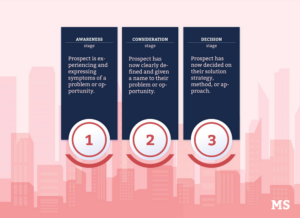
Image source: MarketSplash
Purchase
Here is the point at which the customer goes onto your website and makes the actual purchase.
Post-purchase
This is where customers receive their purchased item(s). They may need to return the item, exchange it, or request a refund.
Retention
Retention or loyalty is key in any customer journey map as it is this stage that has the potential to lead to repeat purchases. Or, in the case of digital goods, like a video streaming subscription for example, retention is key to ensuring business profitability.
Customers who feel valued and appreciated are more likely to come back to your store for repeat purchases, or to continue their recurring billing for the service beyond the initial trial period. Therefore you should always be looking for strategies to improve customer retention and figure out your customer’s value.
Advocacy
Sometimes (in the best cases), your customers become so loyal to your brand that they start to spread news of your business through word of mouth, they share positive reviews online and they may even opt to become your affiliate partners.
Why go through the trouble of making a customer journey map?
The benefits of having a customer journey map include seeing what actions your customers are taking when they’re on your channels, which gives you insight into what content works best and what messages resonate most with them.
It will also give you an idea of what types of products and services appeal to different segments of your audience, helping you target your messaging more effectively.
Let’s take a look at an example of a customer journey map.
An Example: Spotify’s Customer Journey Map
Spotify, the music and audio streaming service, hired an external marketing agency to help them determine a strategy of how they can motivate more of their users to share the songs they are listening to through their various communications channels.
They also wanted to assess what the customer experience was in regards to their sharing features and how this could be improved.
To help them research these questions they created a customer journey map of the music-sharing experience (see below).
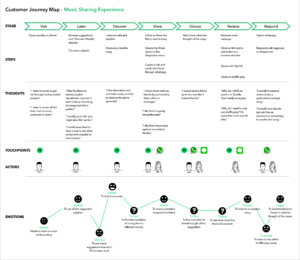
Image source: Meghana Bowen
By looking at the map you can see that they have pinpointed the entire journey of sharing music, from opening up the Spotify app on a phone, all the way through listening to and sharing a song, and finally to whether the song they shared was received positively or negatively by their friend.
During each stage, the marketing agency goes as far as to list exactly what they would expect Spotify customers to be engaging with, doing, and feeling. This information was collected through customer surveys.
This thorough customer journey map allowed Spotify to identify the friction points that users may have been experiencing. They could then address these issues and make the music sharing experience as easy as possible, in an attempt to encourage more users to do so.
Follow These 11 Steps When Creating An eCommerce Customer Journey Map
When creating a customer map, whether it be for eCommerce or not, you need to take a number of steps to have the best chance at success. Here are 11 simple steps to follow.
Define Your Goals
First things first: you need to know exactly why you’re doing this.
- What do you hope to achieve by mapping out your customer journeys?
- Are you looking to improve conversions?
- Do you want to increase sales?
Or maybe you just want to get a better understanding of how people interact with your brand.
Whatever your goals are, make sure you have them clearly defined before starting.
Know Your Target Audience
Once you know what your goals are, you need to identify who your ideal customer is going to be. This means identifying who they are, what they like, and what motivates them to buy.
Knowing your target audience makes it easier to create a map that resonates with them. Inspiring relevance among users can help your odds to nurture them into loyal customers and, as mentioned above, they may become your advocates or affiliate partners.
Create Customer Personas
Think about who your ideal customer is. What do they look like? What are their interests? What are their motivations? Once you have answered these questions, you can begin to build personas.
Personas are fictional characters that represent real people.
They are used to describe your target audience. Creating customer personas helps you understand your customers better. It enables you to put yourself in their shoes and think about how they might behave.
Think about what kind of problems they face, what motivates them to act, and what their needs are. By putting yourself in their shoes, you can then tailor your offering to meet those needs.
If your business has more than one customer persona then it is important to create a customer journey map for each one.

Image source: MarketSplash
Host Focus Groups
If you don’t already have any data to work with, you can always collect some from your current customers. Ask them if they’ve experienced certain issues while using your product or service.
You can easily create focus groups of existing customers and then ask them exactly what their touchpoints and pain points are when interacting with your brand.
This qualitative research methodology can take many forms, from in-person one-on-one interviews or group discussions to online meetings, to in-store assisted visits or even record-keeping/journaling tasks. You can use the information gathered from the focus group to help inform the rest of your customer journey map.
Engage With Your Customers
Talk to your customers, respond to their questions and concerns, and listen to feedback.
Make sure you keep your ears open because you never know what information you might learn from them. You may even find that some of your customers are willing to help you test new ideas and products as well.
It is also equally as important during the engagement stage that you answer any questions your customers have, this will give you an idea of the information that is missing in your marketing content and help you make that information as easy to access as possible. Thereby making their buying process easier.
You can engage with your customers via social media channels, live chat, through your website, or via a customer service channel such as phone call or email. We suggest that you use a number of these channels to make the lives of your customers even easier.
Below you can see an example of a B2B customer journey map from Customer Journey Maestro that includes the all-important step of customer engagement:
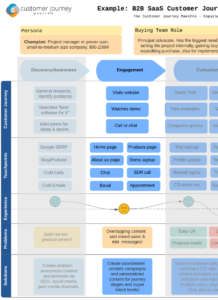
Image source: Customer Journey Maestro
Use Analytics Tools To Monitor Customer Behavior On Your Website
Using various website visitor tracking tools and analytics tools such as Google Analytics allows you to track data related to your website traffic.
You can use these tools to find out where visitors come from, how long they spend on your website, and even what pages they visit. Analytics tools can help you identify any issues with your website and provide valuable insights into how users engage with your product.
Identify Customer Touchpoints
Now that you’ve collected all the data you can, it’s time to start thinking about the key points of interaction (KPI) that matter most to your business.
Identifying these interaction points or touchpoints is important because it helps you understand where your customers are coming from, what they expect from your brand, and what they need from you.
Touchpoints could include your website homepage, specific product pages, email notifications, in-app actions, customer service channels, social media platforms, and more (see image below for an example).
Include as many touchpoints as possible. You don’t want to miss anything!
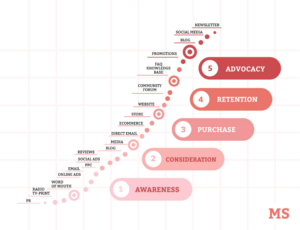
Image source: MarketSplash
Map Out Customer Journey Stages
It is time now to map out your customer journey stages and see which ones work well and which ones don’t. This is just the rough planning stage of your customer journey map. It will change.
Start by creating different scenarios based on your business objectives.
For example, if you want to increase sales, you would probably want to look at your top-performing products and analyze what made them successful and how customers interacted with your brand, before, during, and after purchase.
Once you have identified the scenarios and customer journey stages that make sense for your business, you can move on to the next step.
Use Data To Find Out Where The Pain Points Are
The data analysis step may not be in your customer journey map, but the potential pain points it uncovers may be. This is shown below in the B2B customer journey map example. The pain points at each stage of the customer journey are identified as barriers.
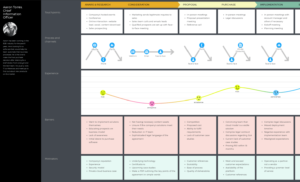
Image source: eDrawSoft
Behavioral science tools such as heatmaps and click maps help you gain insight into user behavior. They show you where your customers click on your site and what they look at.
They can also tell you if they bounce off your page or stay longer than expected. Identifying pain points is important as it lets you figure out what changes you should make to improve your conversion rate.
To identify pain points you need to collect as much information as possible from your customers through reading reviews, support tickets, surveys etc. This data then needs to be examined using manual techniques or artificial intelligence so that the common issues amongst customers can be identified.
Fix Any Issues With Your Customer Experience
It makes no sense to identify a pain point and then not do anything to fix it. It doesn’t work like that. You must try to fix as many friction points as possible.
This step may not always form part of the actual customer journey map, however, it is still vital in creating an accurate customer journey map and providing your clients with a seamless experience.
If there is something wrong with your customer experience, you will lose potential revenue. So make sure you address any issues that arise. This includes fixing bugs, improving navigation, adding new features, and so on.
Below is the customer journey map of ProductPlan, the product roadmap creation software. This graph captures customer pain points and then the potential impact of fixing these issues is shown as ‘insights & opportunities’.
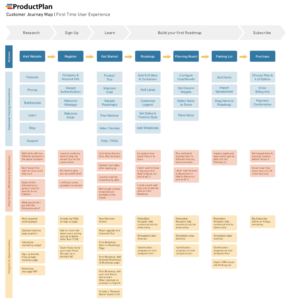
Image source: ProductPlan
When it comes to solving your customer pain points there is no set formula. However, there are a number of things that you can keep in mind to make the process as easy as possible.
When solving issues, never assume that the customer is even aware of this matter solve common problems first, establish an omnichannel method of customer support, and most importantly – implement a customer feedback loop so that they are left feeling heard.
Create The Map And Continually Improve It
So if you’ve followed all the steps above, it is now time to create the actual customer journey map and continue to improve it over time.
Once you have created the map, you can add new features, remove old ones, and update content accordingly.
The goal here is to continually get better at understanding your customers’ needs and expectations. By continuously listening to their feedback, you can ensure that your online store continues to meet their needs.
The Bottom Line
A customer journey map is an essential tool for every eCommerce team. It provides you with a clear picture of your customers’ expectations, behaviors, needs, and preferences. It helps you understand your target audience, what they value in your product, and how they interact with your brand.
A customer journey map gives you a better understanding of your customers’ buying process and helps you plan future marketing campaigns.
You can also use this information to optimize your content strategy, design your site, and develop effective landing pages. It also helps you identify areas of improvement and pinpoint problems that may affect your sales revenue.
About Author

Darya Jandossova Troncoso is a photographer, artist, and writer working on her first novel and managing a digital marketing blog – MarketSplash. In her spare time, she enjoys spending time with her family, cooking, creating art, and learning everything there is to know about digital marketing.

